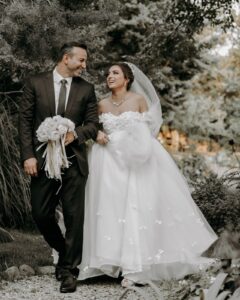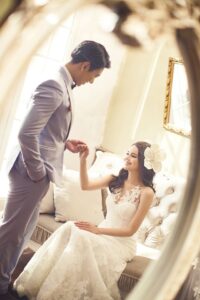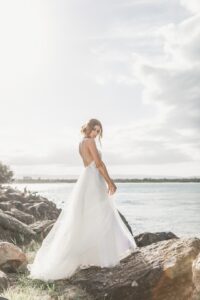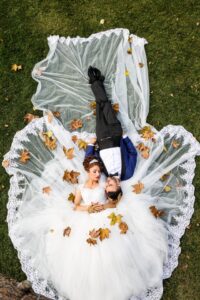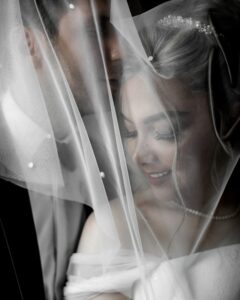Click here to see the table of contents
A few things you must know about the Wedding Photography
“What I like about photographs is that they capture a moment that’s gone forever, impossible to reproduce.”
~ Karl Lagerfeld
From re-arranging the seating chart to fit your third cousin (twice removed) to finding something new, old and blue — you’re busier than a weatherman in a tornado. No worries, we’ve got your back; it’s kind of our thing.
Below you’ll find a treasure trove of wedding wisdom — all of which spilled out of the mind of Business Weddings.
Photographic Memory: The History of Wedding Photography
Berenice Abbott once said that “photography can never grow up if it imitates some other medium. It has to walk alone; it has to be itself.” But photography has grown up — and just like the couples who grew up and developed generations of progeny alongside it, wedding photography has matured.
When we fell in love with wedding photography we fell in love with everything about it — including its rich history and the traditions that evolved over centuries…
Wedding Photography – The Mid-1800s
The photographic art form was not invented until the mid-1820s, and it was extremely expensive for most couples to hire a photographer during an actual wedding. Instead, most couples would dress in their best, non-wedding clothes later on for a formal portrait.
It wasn’t until the 1860s that posing for a portrait in wedding attire became popular, and with it came the trend of bringing a photographer to the actual wedding (which by this point had become more convenient). Despite the growing trend, however, the photography equipment of the time was anything but portable, so studio photography was still the norm.
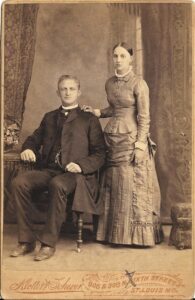
Photo credit: vrieck@bluecrab.org | Source: Almanac.com
GEORGE & BARBARA SCHEVEL
In the right side you can see a perfect example of how a 19-century wedding picture looks like:
\”My grandparents, George Schevel and Barbara Goehringer, on their wedding day in the late 1800s. Brides, at that time, wore dark gowns and grooms wore wedding rings on their right hand.”
Wedding Photography – The early 1900s to WWII
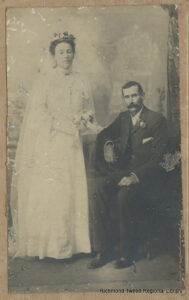
About the picture: Paddy and Mary Ryan, early 1900s | Source: Flickr
While color photography was available during this era, it was far too expensive for the average couple to afford. The majority of the photos available before WWII were always black and white, and few and far between.
The war itself, however (WWII) is credited with revolutionizing modern, portable cameras — thanks to the evolving need for war-based photo documentation. The invention and availability of the 35mm camera during this time made it possible for military-trained photographers to capture images of the war, which evolved into photojournalism as we know it today.
Once the war was over many of these military-trained photographers, who were no longer employed by the army, instead found work by snapping photos at weddings and selling them to the couples. It was these wartime photographers that began the practice of documenting weddings and taking more candid-style photos.
Wedding Photography – The 1950s and 1960s
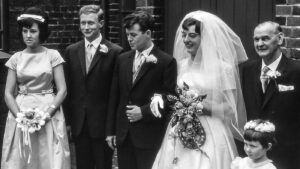
Photograph by MrJamesAckerley is licensed under CC BY 2.0 | Source: ONS.gov.uk
During the 1950s and 1960s, our celebrity-obsessed culture became fascinated with all things weddings — and celebrity and royal wedding spreads began covering the glossy pages of high-end magazines. Candid photos of these weddings were in high demand, driving the art form further into the mainstream.
Wedding Photography – The 1970s and onward
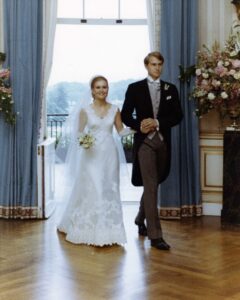
The image in the left side represent the marriage of Tricia Nixon and Edward Finch Cox. Read more about it here: Richard Nixon Foundation
Throughout the 1970s and beyond, the photojournalistic and candid approach to wedding photos began to become more commonplace. And as equipment evolved, and became less bulky, so did the photos and the ability of the photographer to capture the emotion of the day.
Wedding Photography – Photojournalistic Wedding Photos
Photojournalistic style is the difference between Ansel Adams and uncle Jim (with his 80s Polaroid). Images were taken with photojournalistic styling compose a narrative for your entire event. They’ll focus on the beautiful lighting, candid moments and angles that make all the difference.
A photojournalistic style means a fly-on-the-wall approach from your photographer. No herding your family together for awkwardly-posed shots (unless asked!). There’s no “move your head this way” or “Auntie Jeannie — look at the camera.” Instead, they understand how to work the moment to create heart-stirring shots with what’s available – and it works.
You should seek a wedding photographer with a photojournalistic approach. An approach that means…
- They aren’t standing around waiting for the required cake cutting or bouquet-toss shots than taking off. They are capturing moments you didn’t know were there.
- They catch little things, like the bride texting in one hand and applying a final and perfect coat of lipstick, or the bride making that last-minute, tear-filled adjustment to her mom’s jewelry before heading down the aisle.
- The guests turning to catch the first glimpse of the bride
- The look on the groom’s face as he sees his bride — again — for the first time.
- The family bonding of far-flung relatives.
- The ring box, casually in hand behind the ring bearer’s back.
- The groomsmen gathering for their first drink at the bar.
- The laughter and hope on the couple’s faces during the speeches.
Photojournalists not only catch the important moments — they are also in the right places at the right times and are accommodating to a fault because after all, but it’s also your wedding. They will also make the kind of suggestions that only years as a professional photojournalist can bring — like to whisk the bride and groom away to a quiet garden outside for a stunning photo (and for a much-needed break for the harried couple).
A photojournalistic photographer will tell a story and pack it with warmth and emotion — without skipping a beat.
Wedding Photography – How to Look Your Best in Your Wedding Photos
If there’s a common question I get from most brides, it’s how they can look their best in wedding photos. This is a natural question because every bride-to-be wants to look stunning in each — and every — photo. They also want to know what we can magically ‘fix’ after-the-fact with our super-powered, blemish-removing, color-correcting editing skills.
To help you know how to look your best — and what we can do to help — here is a list of wedding photography best practices:
Glasses
The best focal point of any wedding picture is your eyes, and glasses hide your eyes completely when they pick up glare or reflections.
If you are unable to wear contacts on your wedding day, you can use an inexpensive jewelry screwdriver to angle your eyeglass lenses downward–this will significantly reduce the chance of glare on your glasses. If you like your glasses — heck, it’s the daily you right? — but aren’t able to angle your lenses, consider quickly popping them out for your photo session. It will cut the glare and allow your eyes to really ‘pop’.
Fabric
Many brides are concerned whether the colors or textures of the bridesmaid dresses they chose will photograph well.
But have no fear, they all photograph just fine — with the right expertise of course. If you’re looking for something to be concerned with we recommend it is the overall comfort of you and your bridesmaids — after all, it’s hard to get stunning candid pics when they are constantly adjusting their strapless dresses.
Can the Photographer Make Me Prettier?
From expensive lenses to external lighting sources you will look utterly breathtaking in your photos. Of course on the back end, your wedding photographer can remove any small imperfections that don’t contribute to ‘you’, like blemishes, unruly hair (even a ton of hairspray can only do so much!) or what have you.
In short, Yes! Your wedding photographer will make you look beautiful.
This question however is the perfect excuse to schedule an engagement session before the big day — to give you a chance to work with your photographer and let them know what your best side is, what (if any) features you’d like kept out of photos and of course to see their shots of you before the wedding.
With a ‘test’ shoot for engagement photos they will be able to pinpoint what photographs well and what doesn’t — while also giving you a few tips for your big day.
Wedding Photography – The Best Way To Display Your Wedding Memories
The enthusiasm — and outright soul-eating impatience — of waiting for your wedding photos is enough to bring a couple to their knees. But what happens after the initial rush?
Generally, once a couple has viewed their photos in an online gallery — just as they would their nephew’s little league pictures on Facebook — the excitement and the reminiscing is over. Then what?
While Facebook is a great medium to share photos online for distant ‘friends’ — what will you show your children, grandchildren, close friends and each other on your 37th anniversary?
Wedding Frames, Canvas and Prints
Prints and frames are a classic way to display your wedded bliss. Printing photographs is an art and a science, just like photography itself. And how you display your images will define your relationship with your memories. Our best tip for choosing your wedding print is to looking for archival photographic paper. That prevents fading and loss of quality, right up to your 53rd anniversary.
Wedding Albums
Professional coffee table-style albums become a piece of memory-based decor in your home. Guests, family and yourselves can peruse it at your leisure — a streamlined album with the photos that tell the story of you as a couple.
Wedding albums also make a great thank-you gift memento for the wedding party, and they make a beautiful gesture as gifts for family and friends who could not make the wedding due to geography or illness.
A wedding album is a decorative focal point in your home that tells the story of you — something a bowl of fruit or potted plant doesn’t have a snowball’s chance in hell of doing.
Why You’ll Never Regret Buying a Wedding Album
If you’re like me then you remember walking by your parents’ wedding picture in the hallway, and flipping through their hand-stitched album was a formative part of your childhood. Those pictures helped form your idea of what marriage means. There was a sense of comfort and permanency in those photos — something that clicking a mouse or inkjet printers just can’t do.
Of course the beautiful redundancy of digital images — saved to DropBox, your email, Facebook and 97 other places — is important, as a backup, but can never and will never replace the nostalgia of photos. Photos — and their encasements are irreplaceable, but not in the ‘digital’ sense. Vivid photos are what make the visual memories special and drug-store photos simply put, won’t be vivid for decades to come, nor will they give your photos have the depth that professional photography gives your day. They won’t be fifty-year-old photos that freeze your love in time for future generations.
The question becomes, what are your memories worth?
Photo albums are expensive. We know… But that’s because custom-designed and hand-stitched, memory-filled keepsakes created just for you usually are. And they’re worth every penny. Not one of our brides has ever said she regrets forgoing a fancy centerpiece, an all-too-short limo ride or inviting that 9th cousin twice removed in exchange for a personalized wedding album full of depth-filled photographs.
Also, keep in mind that the bride and groom aren’t the only ones to not regret the forgone butterfly release in exchange for memories — your future generations will appreciate the sacrifice, because they won’t be in attendance, they may not know what Facebook is and likely won’t be sorting through your DropBox after you’re gone.
Finally, if you cared enough to read through this post AND enough to hire a professional photographer then you care deeply about cherishing these moments forever. To pay a pro photographer, then print them on cheap drug-store paper with low-quality ink is like taking a private jet to a two-star resort. Invest — it will be the best decision you’ll make since he proposed and you said yes.
DIY Wedding Photography
No, we’re not suggesting you forego a professional photographer or videographer in lieu of an Instamatic tucked into the folds of your ball gown. Still, we’ve got some great ideas on how to jazz up your wedding album with some homemade memories. Go for it!
- Outfit your bridesmaids and groomsmen with disposable cameras and ask them to snap away as they prep and primp for the big day. Also, be sure to place beautifully decorated disposable cameras on every reception table. What a great way to get a guest’s perspective on your gala event.
- Put on a cocktail hour slide show! Gather the cutest, funniest and most beloved family shots and have them transformed into slides. Then, while you’re off having your newest pictures snapped, your wedding planner or reception coordinator can dim the lights, switch on the projector and bring down the house.
- Create a framed guest book. Blow up your engagement picture and have it matted on archival cardstock. As guests arrive, ask them to sign the matted border. Once the picture is framed, you’ll have a guest book to hang on the wall with all your other favorite prints.
- Create mini photo albums for your attendants. Once the pictures are back from the photographer, choose small beautiful albums in which to show them off. For a special touch, include favorite snapshots from all those showers, parties and dinners.
- Don’t know what to do with the hundreds of pictures from your disposable cameras? Create a one-of-a-kind photo collage. Trim the edges of snapshots and use spray adhesive to mount them on heavy cardstock.
- Sew a photo quilt. Chances are your local photocopy store that can make fabric transfers out of photographs. Transfer a dozen of your best shots onto squares of muslin and whipstitch them together for a great wall-hanging.
- If you can get your hands on a video camera, have a friend or family member fire it up for showers and engagement parties, not to mention the rehearsal and dinner. That way, when it’s all a memory, you can fully appreciate the flurry of exciting events of which you were the focus.
HOT TIP
As a wonderful thank-you gift, frame a picture of yourself and your bridesmaids getting ready for the wedding. Such a special memory, beautifully captured and framed, is sure to be cherished. And besides, every woman needs at least one glamorous candid.
Wedding Photography Q&A
Q1: Are There Ways To Save Money On Photography?
Answer:
Photography packages vary greatly, but you should be able to find a quality photographer who can provide you with a package within your budget. First, decide how important your wedding pictures and video are to you, and budget accordingly. Remember, you’ll have these images forever, so think carefully before you trim away extra costs. Here are a few tips for getting the most out of your investment.
Shop Around: Photographers’ fees vary widely depending on experience, background, and demand. Take your time researching the best available vendors within your price range.
Add the Parents: Even if your parents plan to purchase albums themselves, you may get a better rate by incorporating their album requests into your initial quote, rather than buying them post-wedding.
Album Notes: Leather albums are pricey and not the only option — photographers usually offer more basic albums. If the budget’s tight, your photographer can simply provide the photos and you can put together your album. Just make sure you use acid-free paper.
Keep It Short And Formal: Need to cut a few more dollars? Hire a professional to capture only the posed formal wedding photographs. Photographers who shoot candid shots use more film, and the cost adds up. Supplement your formal photos by asking a few shutterbug friends to snap candid pictures throughout the reception.
Color Your World: Black-and-white photos are often printed by hand and can be significantly more expensive than color photography. Ask around, and if you find this to be the case, ask your photographer to work entirely with color film.
For The Brave At Heart: Hire an advanced student from a reputable photography or film program to photograph or film your wedding. As a bonus, many students will charge a flat fee and give you the negatives. Be sure to research carefully if you choose this option.
Too Good To Be True: If you find a photographer whose prices are very low, make sure to go over a large sampling of their wedding-related photos and talk to at least three references before you hand over the deposit. Beware of any photographer who insists that you pay in full before your film has been developed. You’ll find it hard to get your money back if the pictures don’t come out.
Q2: Are There Basic Photography Terms You Should Be Familiar With?
Answer:
If you want a certain style or type of film, you should definitely know what you’re talking about when you interview photographers. Here are the basics to learn before you head to the studio.
35 mm: A type of film used in most cameras. 35 mm describes the size of the negative. It also refers to cameras that use 35 mm film.
4 x 5: A large-size film often used by professional photographers for portraits and landscapes. The negative measures four inches by five inches. It also refers to cameras that use 4 x 5 film.
Candid: A photograph that is not posed. Generally taken without the subject’s awareness.
Documentary Style: A style of shooting videotape or film that includes interviews, and candid or unstaged scenes.
Fisheye: An extremely wide-angle lens used to create photographs with a distorted ’rounded’ effect.
Infrared: A special film that reacts to the infrared light spectrum. Results in dramatic color shifts in color film and ethereal glow in black-and-white film. This film requires special handling and processing.
Internegative: A negative created from an existing photograph. Allows new prints to be made from a photograph if the original negative has been lost. Often results in higher quality images than direct scans of the photograph.
Medium Format: A film type with a negative that is larger than 35 mm film. The resulting pictures can be used to create quality prints that are much larger than can be done with a 35 mm film. It also refers to a camera that uses medium format film.
Multiple Exposure: A process during which a picture is exposed to light several times, either at the time the picture is taken or later, during printing. Multiple exposures can create many different effects.
Negative: Film that has been exposed and developed. Light is projected through the negative to create the finished print.
Online Photo Showcasing: Displaying proofs of an event online, which enables you and your guests to easily view, share, and purchase professionally captured images – anytime, anywhere.
Panorama: A special camera that allows the photographer to take a picture with a much wider view than normal — up to 360 degrees, depending on the camera. These cameras require a special film.
Portrait: A formal, posed photograph.
Prints: The final, retouched photographs purchased by the newlyweds and their loved ones.
Proofs: Normal-sized pictures used by the couple to select prints. Proofs have not been retouched and must often be returned to the photographer.
Retouch: The process by which the photographer removes tiny imperfections caused by dust or other debris from the photograph. It can also be used to remove skin blemishes from photographs.
Selective Focus: A technique in which one portion of a photograph is in focus while other elements are blurred. The viewer’s eye is naturally drawn toward the part of the photo that is in sharp focus.
Sepia: A golden brown tint sometimes applied to black-and-white pictures. It can give the finished print an antique appearance.
Shot List: A list of required photographs provided to the photographer prior to the wedding. Includes the subjects of each photograph and any additional pertinent information.
Soft Focus: A technique using a special lens or attachment, which softens all of the edges in a photograph. The resulting picture appears as though the subject was photographed behind a light layer of gauze.
Telephoto: A special type of lens used to photograph subjects that are far away. Essentially functions like binoculars for the camera.
Q3: How Many Shots Should The Photographer Take At Your Wedding?
Answer:
This number is going to vary depending on where you live and the style of your photographer. After a seven to eight hour day, you should at least have 200 to 400 images. I usually deliver from 400 to 800 proofs depending on the size of the wedding, with a combination of medium format and 35mm proofs.
More is not necessarily better. Keep in mind, the more images you get back, the harder it is going to be on you when the time comes to narrow the selection down to assemble your wedding album. You want a nice selection to choose from without being overwhelmed with thousands of just OK images. I try to shoot as many great images as possible, and then I edit my shots and deliver to my clients the best shots from their wedding.
Q4: Are There Certain Photography Shots That Brides Often Overlook?
Answer:
If you want more than just portraiture, ask your photographer to include these memorable shots.
• Engagement session
• Bride applying makeup
• Close-up of hair from the back
• Details of dress
• Bride by herself
• Groom by himself
• The bridal party carrying the bride’s veil or train
• Groom sweeping bride off her feet
• Close-up of bouquet
• Fisheye shot of ceremony aisle
• Detail of cake
• Close-up of bride and groom’s faces during the first dance
• Bride throwing bouquet
• An infrared shot of couple kissing
• Guests dancing
• Couple leaving in a limo
Q5: Can You Find A Photographer Who Reflects A Timeless Style?
Answer:
For a classic look, seek out a photographer who’s adept and experienced in both portraiture and photojournalism. Often times a photographer may excel in one format, but lack experience in the other. Do a thorough research and be prepared to go on many interviews. Start with recommendations from friends whose wedding photos you admire, then browse our local section to review online portfolios and check out other brides’ comments on our message boards. When looking at a photographer’s work, ask yourself whether those are the types of shots you could see yourself in.
Also, keep an eye out for variation. Classic indicates refinement, but it doesn’t mean boring. An expert will get that formal portrait of you with your parents, but he should also remember to take detail shots, such as the buttons on your dress or your monogram cake topper. You may also want to consider the different types of processing the photographer uses. Do you want more than just color photos? Look for black-and-white, sepia tones, and other special techniques, such as hand-tinting. The only caveat is that multiple styles, formats, and finishes mean spending more money. If you want it all, be sure to budget accordingly.
Q6: Can A Photographer Combine A Mix Of Techniques?
Answer:
If you’re intrigued by all the methods and styles out there, find a photographer who is open-minded and ready for anything. Consider how far each photographer you interview is willing to travel, their personalities, and their level of experience with various types of weddings. Do they have a set shot list they prefer to work with, or are they open to your suggestions and ideas? Ask about the types of finishes they can provide as well — color, black-and-white, and sepia.
You’ll also want someone familiar with the high-art look of fish-eye and infrared pictures. The infrared film creates a hazy, ethereal glow, resulting in a dramatic surreal effect. A wide-angle “fish-eye” lens creates a distorted, rounded image. Incorporating these techniques will create variety in your album and reflect your diverse style.
Q7: Can Your Photography Style Reflect Your Personality?
Answer:
Yes, finding the right photography style for your wedding depends on one thing — who you are. And because photographs are intensely personal, they should reflect your style. Make sure your pictures capture the essence of your wedding: the emotions, the loved ones, and all the details, from beginning to end. Pick the personality below to learn more about choosing the perfect photography package.
Q8: Do I Need To Give My Photographer A “Shot List“?
Answer:
It’s always a good idea, as with any relationship, to communicate your ideas and thoughts with your photographer before the wedding day to make sure you are both on the same page. If you have hired a reputable professional photographer, he or she is going to cover most standard shots that you might have on a list. If it will make you feel more comfortable to have a list, then put on your list the shots your photographer may not know to get, like the bride with sorority sisters or godparents.
Make sure you give that list to someone in the family who knows both sides of the family to guarantee that you get all the images you want. Your photographer cannot place names to faces. That’s why it’s important to put a family member in charge of the list. It is also important that you make sure the people on your list are there when it’s their time to be photographed. If your people are not there, it’s not fair to hold your photographer responsible for missed shots.
Q9: How Can A Wedding Photographer Evoke A Natural Feeling?
Answer:
Find someone who specializes in photojournalism and has a knack for making wedding pictures look natural. The right photographer can make even your staged portraits look inspired. When analyzing a portfolio, look for relaxed faces, bright eyes, and genuine smiles. The photographer’s photojournalism work should demonstrate the ability to capture emotions, evoke a sense of history and movement, and unveil relationships intuitively and honestly.
In addition to expertise in style, you’ll also need to consider the photographer’s experience in shooting outdoor events. Ask to see shots that were taken during a similar time of day and location as your wedding. A professional may snap stunning images when the sunlight is working its magic, but are his skills up to par when the clouds roll in? Does he have the right wide-angle lens to grab those sweeping panoramas of the scenic background? It may take some time, but plan on looking through many portfolios to find someone who’s mastered the art of taking a natural shot in a natural environment.
Q10: How Can You Help A Camera-Shy Mom Relax For Pictures?
Answer:
If possible, take your mother to meet your photographer so she can get to know him or her, just as you would. You might take her along for your engagement session or arrange a special session with just the two of you.
If this isn’t possible, make your photographer aware of Mom’s camera fright. Ask him or her to grab some shots of Mom when she isn’t aware. I like to use this technique during the cocktail hour. I walk around with a telephoto lens, singling out guests and taking their portraits, unbeknownst to them.
Another sure-fire technique for natural smiles during the family or posed portraits is to hug. I ask my subjects to get in close and give each other a nice squeeze. When people hug, whether in a group or just as a pair, they naturally smile. I also smile at my subjects when photographing them. It’s hard not to smile back at someone who has just smiled at you, so make sure your photographer smiles a lot.
Q11: How Much Money Should You Spend On Your Photography in 2024?
Answer:
Statistics say you should spend somewhere between 12 to 18 percent of your overall budget on your photographs. Keep in mind that, as in most cases in the wedding industry, you get what you pay for. The importance you place on your photography should be reflected in how much you spend.
Photographers’ rates vary depending on where you live and the caliber of the photographer you hire. The more expensive photographers usually command a higher price based on the quality of their work and demand for their services. This does not mean that a less expensive photographer cannot be as good. Photographers have to start somewhere, and there are always great up-and-coming photographers in every city. Sometimes you just have to search for them. There is a lot of great talent out there, so if you look hard you just might find a diamond in the rough.
Regardless of how much you spend — whether you spend a little more than you thought you would ensure that you get exactly what you want or you have a budget that you absolutely must stay within — the most important thing is that you hire someone you both feel comfortable with. It’s important to remember that you are not just buying albums and pictures, but the person who will take those images as well. Ask friends and coworkers who have recently married for referrals. Make sure the photographer has a good reputation so your photographic experience is a positive one before, during and after your wedding.
That’s said, in 2024, a wedding photographer fee may start from $800 and went over $5000. It depends on many factors, like how well-known he or her it is, what kind of equipment will use, how many hours will shoot and more.
Photography is one of, if not the most important place you can invest your wedding dollars. In the end, after the flowers are dead and the food is gone and your dress ends up in a box in the garage, all you have left are the images your photographer shot. Those images, as they age, become more valuable
Q12: How Can You Tell If A Photographer Is Great Or Not?
Answer:
First, research each photographer’s work on the web — most professionals have websites that display their efforts. Then, make preliminary appointments to view their “books,” or portfolios of the weddings they’ve covered. (Make sure when visiting a prospective studio that you are looking at the work of the photographer who will actually be shooting your wedding, as some studios feature several photographers.)
Ask yourself if the photos have good color and clarity; if there are plenty of detail shots; if the emotions and expressions of the day were captured; if the style is something you would want for your own wedding album; and if the poses are creative or just standard.
Once you’ve narrowed it down to the photographers whose work and style you really like, ask some additional questions that can help separate the true professionals from the ordinary vendor. Do they have back-up equipment in case there’s an issue? Do they dress formally when photographing a wedding? Are they familiar with your ceremony and reception location(s)?
Finally, ask for a list of references you can contact – if a photographer claims he can’t provide you with one, skip him. If he does provide a list, call at least three references before making a final decision. By following our advice, you can spot the truly talented and avoid the vendors that come with the risk of disappointment.
Q13: Should You Choose Traditional Or Photojournalistic Photography?
Answer:
If both styles of photography are important to you, you should definitely not settle for one or the other. I would say 95% of my clients want both as well. Make sure that when you hire a photographer, you not only like their work, but you like their personality. Photography is one of the most important aspects of your wedding. Your photographs will be all that you have left once your wedding day has passed. If you need to spend a little more on photography to get what you want, then I would suggest you do that and maybe shave your budget in other areas.
One way to find out if this is the right decision is to put yourself in your shoes three weeks after your wedding when you receive your proofs back from your photographer. You went with someone who, let’s say, just shoots photojournalism. The photojournalistic images are everything you ever wanted, however, there are no pictures with all your family together, there isn’t one photo with your grandparents, and your maid of honor somehow did not end up in any of the shots. How are you going to feel? You are going to wish you had spent the extra money.
Photojournalism is capturing what is happening not setting up or creating specific shots. Photojournalism also incorporates art as well as emotion, capturing all those elements in a single moment on a piece of film. When looked back upon it brings you back to that exact moment in time or moves you in such a way that it touches your life in a way unique only to you.
Traditional images are those photographs of you, your families, and friends where time has been set aside to make sure those who are close to you are remembered and included as a part of your special day. Including these people sends a message to them letting them know how important they are to you both. These images don’t have to be stiff and boring. They too can have a lot of the same qualities as your photojournalistic images. Makes sure you allow enough time and communicate to both your photographer and families about who needs to be where and when. Make sure you yourself are on time.
As far as the quality of photojournalism vs. traditional, it is going to vary depending on photographer, type of films, and equipment. I shoot a 35mm and medium format. I use 35mm mostly for photojournalism because it is smaller and faster. I can be less obtrusive and get shots that I may not have with the larger, more cumbersome camera.
I use my medium format to photograph the family photos and some of the bride and groom and ceremony as well. I do cross over a lot, and I have no set rules. A medium format negative is usually a better quality because it is larger than 35mm. This really is only going to make a difference if you plan on enlarging prints bigger than 20×24. The majority of the reprints from your wedding images will be 11×14 and smaller. With the quality of 35mm films today, you can enlarge a 35mm negative up to 20×24 and see little or no grain. The most important thing when hiring your photographer is his or her eye and personality, not the equipment he or she uses.
Find the right photographer, have a positive attitude about your wedding day photographs, and your images will be everything you want them to be and more.
Q14: Is Framing The Only Way To Display Wedding Photos?
Answer:
Pictures from your wedding and other wedding-related events can be arranged and showcased gracefully using more than just frames.
Shadow Boxes: These large, deep frames are used to display photos along with other mementos from your wedding. You can pair photos with your wedding invitation, your program, a dried flower from your bouquet, and a matchbook from your reception location.
Professional Paintings: There are many artists and companies — such as Photowow.com — that can create a painting based on a wedding photo. These formal, painted portraits elevate a picture to a piece of art and allow you to display an image uniquely.
Sketches: Having a professional sketch done of a wedding photo is a beautiful way to display a beautiful moment.
Digital Frames: A digital photo “frame” is much like a slideshow, in that it automatically changes images every few seconds so a collection of photos is displayed. This is a fun way to show friends and family groups of pictures and is easy to use. The pictures will be shown in high resolution and a computer or internet connection is not even required for presentation.
Q15: What Is A Photo Guest Book?
Answer:
The information in a traditional guest book is usually limited to guests’ names and addresses. However, with a photo guest book, your guests can insert their pictures alongside their good wishes.
The best way to incorporate this idea is to place your guest book (you will need more than one for a large wedding) at the entrance of your reception. Designate a couple of special attendants to manage the guest table and snap Polaroids of each person.
A photo guest book includes blank spaces next to each picture slot, so your guests can write their messages while their pictures dry. When they’re done, your table attendants slip each picture next to the corresponding note of congratulations. The finished product is a beautiful keepsake for the bride and groom.
With this special type of guest book, you’ll be able to remember your guests’ smiling faces each time you read their heartfelt sentiments. Display it on your coffee table with your professional wedding album so all your family and friends can share in your memories.
Q16: What Is A Shot List? Do You Need One?
Answer:
A shot list includes the “must-have” shots that you want your photographer to capture — and unless you’re willing to risk your photographer missing an important pose, you should definitely have one.
The basic photography shot list should include:
-Wedding Party
-Blended Family
-Bride With Parents
-Groom With Parents
-Bride With Sibling(s)
-Groom With Sibling(s)
-Bride With Each Bridesmaid
-Groom With Each Groomsman
-Bride/Groom With Flower Girl
-Bride/Groom With Ring Bearer
-Down The Aisle
-First Kiss
-Newlyweds Exiting Ceremony
-First Dance
-Father-Daughter Dance
-Bride & Groom’s Hands
-Cake Cutting
-Bouquet Toss
Q17: What Is The Most important Question You Should Ask When Interviewing Photographers in 2024?
Answer:
The most important question should be, ” Are you the photographer who will be photographing my wedding?”
When you hire a photographer you are not buying pictures and albums, you are buying a person. So your first thought should be, who is the right photographer to capture our wedding images on film? Start by making appointments with several photographers to view their work. You may save yourself some time by asking the photographer if he or she has a website you may view before going to the studio. However, it’s very important to get out there and look!
Make sure that, when visiting a prospective studio, you are looking at the photographer’s work that will photograph your wedding. Some photographers, such as myself, are the only photographer in the studio and do all the work personally. Then some studios have one, or possibly several, associate photographers. Make sure that, if you’re not getting the name on the door, you are getting a face with a name, then ask to view that photographer’s work. Make sure the photographer you want to hire is named in the contract before you sign.
Personality and rapport are extremely important. Make sure you both feel comfortable with your photographer because he or she will spend the better part of the wedding day with you. Even if you think this person’s work is the next best thing to sliced bread, if you don’t feel comfortable with your photographer, it will show when you get your images back. You are investing in this person’s vision, creative abilities, professionalism, character, and personality. Ask yourself, “Would I invite this person to my wedding?” because that is exactly what you will be doing.
Along with your memories, your photographs will be the only things you have left once your wedding day has passed. Make sure you hire the right person for you. You want to have great images and pleasant memories to look back upon.
Q18: What Should A Retro Bride Look For In A Photographer?
Answer:
Look for a well-rounded photographer who takes a creative approach in the post-wedding production of his shots. The right person will have an affinity for achieving a range of results using the same image. Ask him to retouch tones or add a “sloppy” white border to some of your prints. By experimenting with different development processes, he’ll be able to give you that vintage look you’re seeking. Request the use of infrared film, which creates a dreamy aura and dramatic color shifts, resulting in a truly romantic and surreal print. But keep in mind that infrared shots should only be used as accents to highlight your more traditional-style prints. By combining color, black-and-white, sepia finishes, and infrared film, you’ll come out a winner with an eclectic collection of wedding memories.
Q19: What Shots Should A Retro Bride Request?
Answer:
In addition to the standard shots of the bridal party and family, retro prints include special techniques and creative poses in black and white and sepia.
- Bride holding bouquet
- Bridesmaids helping the bride put on the dress
- Close-up of dress details
- Bride’s parents only
- Groom’s parents only
- Bride with Maid of Honor
- Groom with Best Man
- An infrared shot of couple gazing into each other’s eyes
- Toasts by Best Man and Maid of Honor
- Back view of couple walking hand-in-hand
- Bride and Groom hugging
- Bride and Groom side by side without smiling
Q20: What Type Of Photography Is Considered Classic in 2024?
Answer:
If you’re a classic bride seeking a traditional format, color portraits are a must. Enlarge the ones that turn out the best and place them in elegant silver frames. You’ll also want to remember every moment by ordering a thick memory album to display on your coffee table.
Although posed color portraits will never go out of style, candid photojournalism has become increasingly popular. Most photographers will be able to shoot this “storybook” style in addition to traditional pictures. With the right artistic ability, your photographer will be able to create photos that will remain modern, as well as stand the test of time.
Q21: What Type Of Shot List Is Best For A Natural Bride in 2024?
Answer:
For the most emotional and natural shots, ask your photographer to add these moments to your shot list.
- On-site landscapes
- Bride hugging dad
- Bridal party laughing together
- Ceremony decor
- Close-ups of bouquets
- Detail of flower petals along the aisle
- The moment when the Groom sees the Bride for the first time
- Sweeping panoramas with a wide-angle lens
- Black-and-white of couple kissing
- Couple holding hands
- Cake cutting
- Candids from guest table cameras
Q22: Why Is Photojournalism-Style Photography So Expensive in 2024?
Answer:
One reason photojournalism is more expensive is the fact that it is usually shot in black and white. Black and white films, papers and processing costs are more expensive. Also, a lot of the work in the lab must be done by hand as opposed to by machine, and the added time and labor cause the price to go up.
The other reason is that photojournalism has become quite popular in recent times. As with any industry, photography prices are dictated by supply and demand, and photojournalism is what people are looking for right now. Couples want images from their wedding that evoke emotion and stop the time — a means to relive the day.
Capturing emotion on film and creating art with the camera is not an easy task, so the photographers who do so well are in demand. And the higher the demand, the higher the price.
Q23: Which Shots Should Be Included For Classic Photography in 2024?
Answer:
A classic bride’s shot list should include the wedding party and family, along with the most poignant moments of the wedding.
- Engagement photo session
- Bride getting ready with the bridal party
- Detail of dress hanging on the door
- Bride with parents
- Groom with parents
- Bride with immediate family
- Groom with immediate family
- Bride with extended family
- Groom with extended family
- Bride and groom with each family
- Bride with bridesmaids
- Bride with the flower girl
- Groom with groomsmen
- Entire wedding party
- Bride walking down the aisle
- Couple saying vows
- Altar kiss
- First dance
- Father/Daughter dance
- Cake cutting
- Bouquet toss
- Couple getaway
Q24: When Should We Take Pictures?
Answer:
There are few hard and fast rules about when to take pictures. Most people shy away from taking pictures before the ceremony, due in part to the old tradition of not letting the groom see the bride before the wedding. This custom is actually a rather sensible emotional safeguard. In the final hours before the wedding, stress can get the best of a bride and groom and keeping them apart is a good way to prevent any disruptive, last-minute misunderstandings.
That said, there is probably no more logical time to take pictures than before the ceremony. The ceremony location is fully decorated, everyone is dressed, no one’s make up has yet to get shiny nor their curls wilted. Many experts suggest the following: Arrange for a quiet, meaningful pre-wedding rendezvous between the bride and groom. She can even walk down the aisle, to music — a kind of final dress rehearsal. That way the bride and groom can still experience “the moment.” Then, pictures can be taken. In coordinating pre-wedding photos, be sure to allow the necessary amount of time, and a cushion so that the wedding party can exit before guests begin to arrive and be seated.
If you still wish to preserve “the moment”: arrange to take all non-“bride and groom together” photos ahead of time (i.e. photos of just the bride’s family, just the groom’s family, etc.) and then you will only need to take the photos that include the couple together after the ceremony. If you are taking photos after the ceremony, be sensitive to the fact that the longer that your photos take, the longer the delay before the bride and groom can make their arrival at the reception – and even the best reception doesn’t really get going until the new couple arrives.

